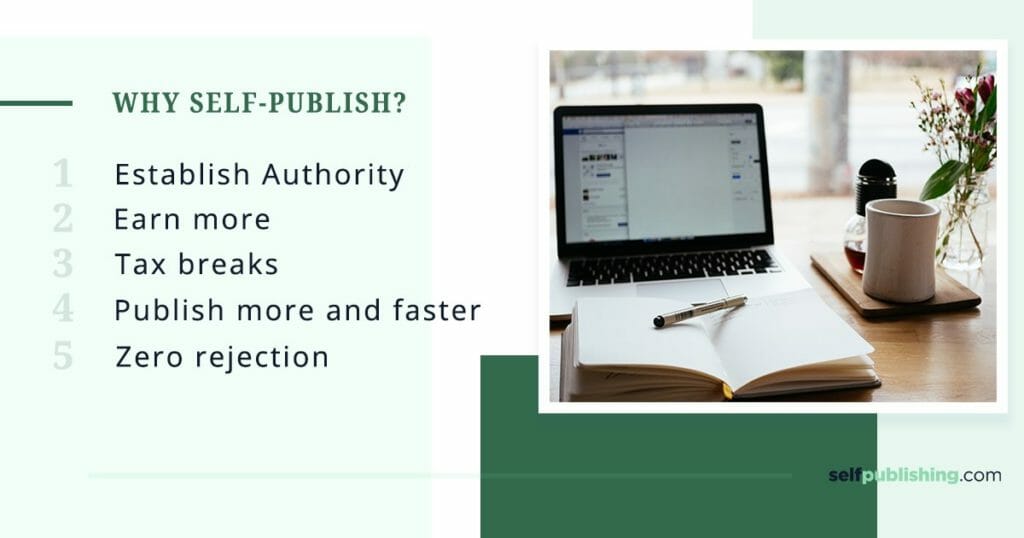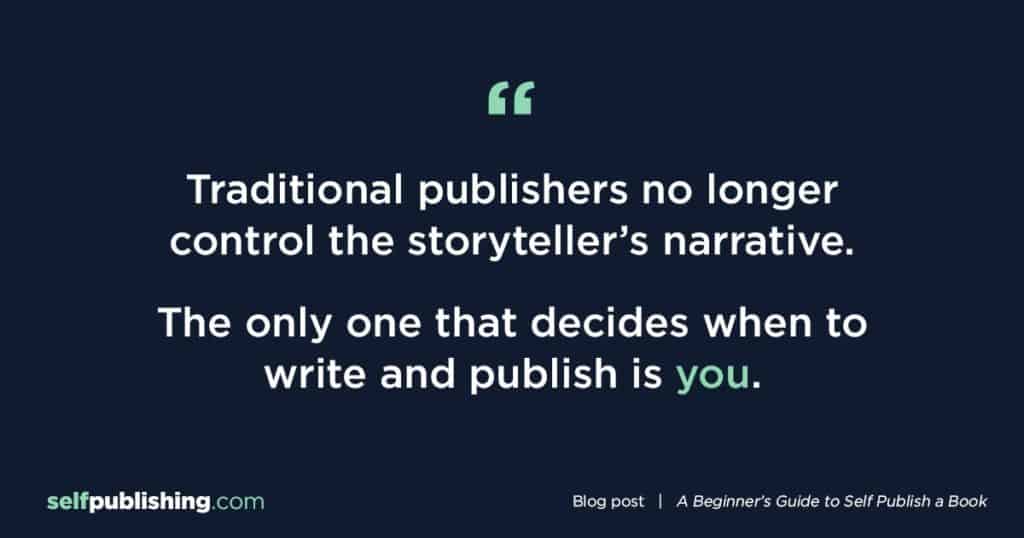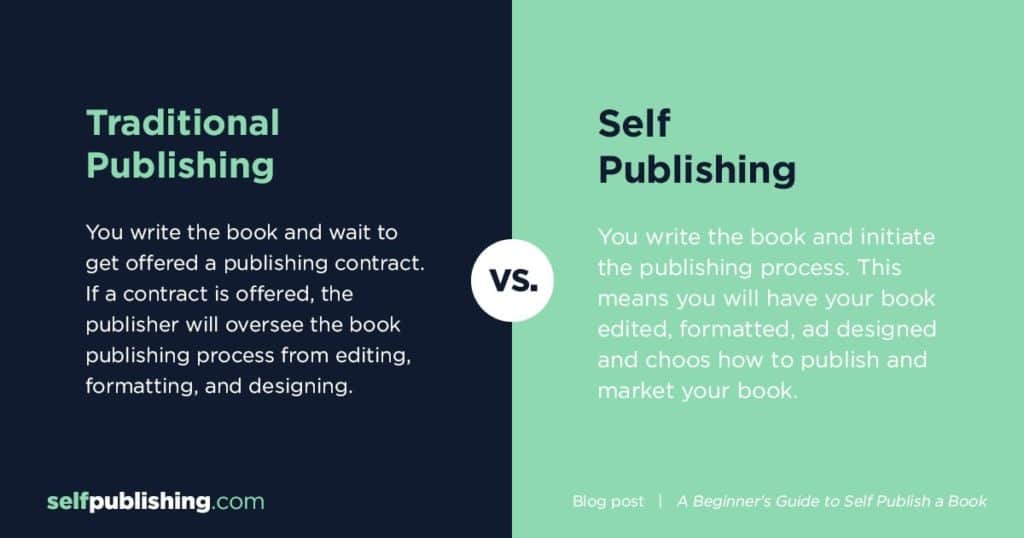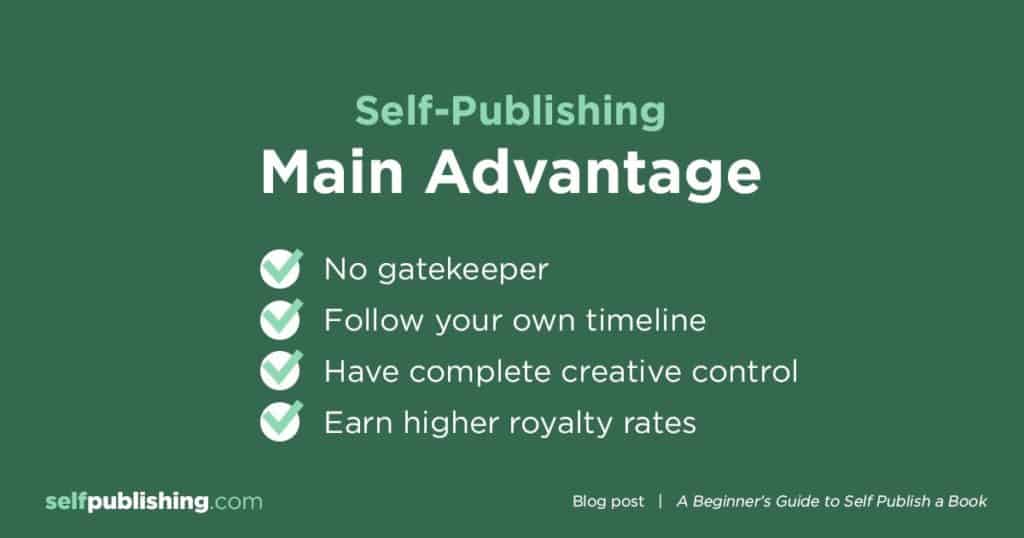
Learning how to self-publish a book is one of the best things you can do for yourself as a writer. Self-publishing is taking the book world by storm…so what is self-publishing exactly?
If you’re a writer researching how to self-publish a book, you’re taking the right step by weighing all of your publishing options.
Self-publishing has become a household term for writers and authors all around the world, thanks to technology.
Being a writer in today’s digital age means you have more options than ever on how to become an author—and learning how to self-publish a book is among the best for those who want full creative control over their work.
What’s the big deal, you ask? Well, until recently, writers didn’t have much of an option outside of traditional publishing if they wanted to write a book.
The problem with traditional publishing is that it’s insanely competitive, and there are a lot of hoops to jump through to even have a chance at getting your book accepted by a traditional publishing house.
But now, the game is changing, and it’s never been easier for writers to learn how to self-publish a book.
In this comprehensive beginner’s guide, we’ll walk you through all the points you need to know about how to self-publish a book on your own. Of course, before you learn how to self-publish a book, let’s make sure you understand a bit about what self-publishing is.
Self-publishing is the act of publishing media yourself without the use of a publishing house or company. Self-publishing is commonly referred to in the author and book publishing industry, but people can self-publish other works of art, such as music and visual art.
In terms of self-publishing a book, an author writes a book and completes the entire publishing process themselves, such as editing, designing, and formatting the book without the aid of a traditional publishing company.
An author who learns how to self-publish a book typically has complete creative control, higher book royalty rates, and full autonomy over the publishing process.
To self-publish, an author will publish a book at their own expense using a self-publishing platform, such as Amazon KDP, and typically maintains full rights to the book.
In short: When you learn how to self-publish a book, you will oversee the entire book writing and production process, from start to finish, at your own expense, and with full ownership of your book rights.

Here are the steps on how to self-publish a book:
You may feel a little overwhelmed looking at the steps for how to self-publish a book, but don’t worry! You don’t actually have to do all of those tasks yourself, but rather you will oversee and fund the process.
Because the entire book writing and production process is your responsibility when you learn how to self-publish a book, it’s important to make room in your publishing budget to hire professionals for the services you need, such as book editing and cover design.

Now that you know what self-publishing is, it’s important to realize that authors weren’t always able to publish a book on their own.
Let’s embark on a quick journey through the history of publishing, which can help you understand how self-publishing is revolutionizing the modern author’s journey.
The printing press was created in 1440, which was a breakthrough technology in making books widely distributed. Thus, the traditional publishing industry as we know it came to be.
In the past and even still today, traditional publishers bought certain rights from the author in order to publish the work.
However, this took the power away from the storyteller, since the traditional publishers served as a “gatekeeper” – ultimately deciding which books would be widely shared, and which would not.
But along came the digital revolution. As with many aspects of our society, the internet revolutionized many industries, including publishing.
Today, writers can use powerful technology and the internet to learn how to self-publish a book and share their stories with a global readership.
Traditional publishers no longer control the storyteller’s narrative.
The only one that decides when to write and publish a story is the author themselves.
In fact, the $1 billion self-publishing market is evidence that it’s become the first choice for many authors.
With today’s growing industry, the road to being a self-published author has widened considerably.

Successfully learning how to self-publish a book on your own can be a time-consuming process, but it’s usually a lot quicker than the traditional publishing route.
While it does require time and effort, the good news is that the self-publishing method can be pretty clear-cut.
Here are the basic steps for how to self-publish a book:
There’s no getting around it, if you want to learn how to self-publish a book, then you need to write one first! Of course, most writers think this is the fun part of the process. It’s also probably the step you are most accustomed to!
If you want to publish your own book, then you absolutely need a title for it. Do some research to help yourself craft a catchy title that will sell (and that isn’t already taken). You might try a book title generator if you aren’t sure how to write book titles.
I don’t care how well you can edit other people’s work – we are all our own worst editors. We know exactly what we meant to say, so sometimes we skim over errors as if they weren’t even there. Hiring a professional book editor will save you a ton of trouble when learning how to self-publish a book.
It will probably take multiple pass-throughs with copy editors and line editors before you have the perfect manuscript. Don’t get yourself down during this process. It will be worth it to have your finished product in the end! Plus, you really do want to catch all those mistakes.
If you don’t have the skills to design one yourself, hire a book cover designer to create an eye-catching cover for your finished manuscript.
The next step in learning how to self-publish a book is to determine whether you would like to self-publish on Amazon KDP, Apples iBooks, or Kobo (more on these options later). This is also a good time to learn how to copyright a book if you haven’t already.
Next comes book formatting. You wouldn’t want to release a book with different size fonts or uneven margins. Nor would you want to use a font that gives your readers a headache. There is plenty of book formatting software that you can use before letting a professional formatter take a pass at your manuscript.
There are so many fun book marketing ideas for before, during, and after book launch. Working with a self-publishing company can help you master these marketing techniques if they aren’t something you are accustomed to.
Now it’s time to price your book. When learning how to self-publish a book, you should think of the price based on format, genre, and publishing goals. Take a look at some similar books and how they are priced. You may also want to offer a lower price for a limited time during pre-sale or launch to get some early reviews.
Book marketing never ends. If you want to keep making sales, you should keep promoting your book! When you run out of ideas, you can always write another book or create a special edition to market.
Remember, this is a condensed process of how to self-publish a book. You’ll want to educate yourself on the best process for each step to avoid making publishing mistakes.
And you’ll notice that many of the steps involved can be tailored to your specific situation.
For example, you can hire a book cover designer, or with the right tools and skills, you can make your own.
It’s important to dive deep into each step when you are working through the process of how to self-publish a book.
If you aren’t sure how to do a lot of the steps above, that’s okay! A self-publishing company can help you.
A self-publishing company helps authors learn how to self-publish a book through the use of technology, services, education, and other means.
Self-publishing companies are mostly for-profit, and depending on the type of services offered, can assist authors and writers in using a publishing platform, helping with editing and other publication services, and assistance with navigating the publishing process and industry.
These are the main types of self-publishing companies:
| Self-Publishing Company Type | Services Offered | Example |
| Self-Publishing Platform | Publishes & prints books | KDP, IngramSpark |
| Author Services | Editing, designing, formatting, etc. | Reedsy |
| Self-Publish Education (now with author services too) | Teach authors to self-publish | Self-Publishing School |
It’s important to understand the differences between self-publishing vs traditional publishing as you determine how to navigate your own author career.
In order to see the big picture and decide whether you want to learn how to self-publish a book, taking an in-depth look at what exactly each publishing type entails is crucial.
In traditional publishing, you first need to land an agent, which can be a very competitive and time-consuming process, with no guarantees.
Once you have an agent, you need to find a publisher to accept your manuscript, which is also a very competitive and lengthy process (and again, no guarantees).
Then, the publisher will offer you a contract that essentially buys the rights to your book.
The publisher will take care of the publishing process from editing, formatting, and designing. You earn royalties based on how many books sell.
Here are the steps to traditionally publish a book:

To recap self-publishing, it goes something like this: You learn how to write a book, you write it, and then have the book edited, formatted, and designed.
Then, you have a printer or publishing platform publish your book, while you market the book and do book maintenance.
When you learn how to self-publish a book, it can be rewarding for a number of reasons. In fact, many self-published authors chose this route simply because of its many benefits.
However, there are also some cons to publishing a book on your own, which we highlight in this section. It’s important to be mindful of the possible advantages and disadvantages as you decide whether or not to learn how to self-publish a book.
| Pros to self-publishing | Cons to self-publishing |
| No gatekeeper | Less support |
| Your own timeline | No one is pushing you |
| Complete creative control | More upfront costs |
| Greater earning potential | Stigma |
| Higher royalty rates | More responsibilities |

For some authors, learning how to self-publish a book can have its downsides. Be sure to consider your own needs and preferences as you weigh the possible cons.
If you’re curious to know whether traditional publishing or self-publishing has greater earning potential, try using our Book Royalties Calculator! It may help you determine if you want to learn how to self-publish a book.